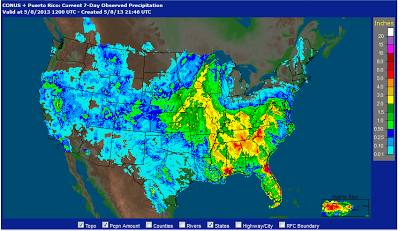It was another eventful weather day across the country, and not in the way you would normally picture the second day of May. The storm that brought snow to an area from the Rockies to northwestern Wisconsin continued to crawl eastward today, leaving a lot of records in its wake. A trough along the central Gulf brought 5 to more than 10 inches of rain to southwestern Alabama and southeastern Mississippi. Dry, warm, and windy weather prompted red flag warnings for southern California and other portions of the southwest U.S.
As of this morning a surprising 10 to 15 inches of snow was on the ground from southeastern Minnesota through northwestern Wisconsin, and accumulating snow continued in Wisconsin during the day.
 |
| Map prepared by the NWS Duluth office |
As you might imagine, May snowfall records toppled with this storm. The NWS Cooperative Observer in Dodge Center MN (Dodge County) reported 15.4 inches of snow in the 24-hour period ending at 7:00 a.m. CDT this morning. If verified, this would be a new daily snowfall state record for May in Minnesota breaking the old record of 12 inches set on three previous dates, the most recent on May 3, 1954 near Leonard, MN. Daily snowfall records were set at many locations in the storm-affected area in Iowa, Minnesota, and Wisconsin.
You can read more about the record snow in Minnesota and Wisconsin at the following NWS office web pages:
National Weather Service, Duluth MN
National Weather Service, LaCrosse, WI
In Omaha, NE the snow on May 1 and May 2 set daily records on both dates. The combined total of 3.1 inches for May 1-2, 2013, is a record snowfall event in May as well as a record highest monthly snowfall total ever recorded in May. In Lincoln, NE May 1 snowfall was 2.4 inches on May 1 and 0.2 for today (May 2), both daily records. Kansas City, MO set new daily snowfall records on both May 1 and May 2. The combined total of 3.1 inches for May 1-2, 2013, is a record snowfall event in May as well as a record highest monthly snowfall total ever recorded in May.
This storm was clearly evident in the temperature pattern across the U.S. today, reflecting the strong upper level trough.
 |
| 500 millibar (about 20,000 ft) upper level map for 7:00 p.m. CDT May 2 |
 |
| Surface temperatures at 7:00 p/m/ CDT May 2 |
The upper level ridge over the western U.S. was providing sunny and very dry weather. In California these conditions along with the
Santa Anna winds combined to produce critical fire wildfire conditions in southern California, southern Nevada, and central Arizona.
Red flag warnings were in effect for most of these areas today.
 |
| Fire weather outlook for May 2 issued by the NWS Storm Prediction Center |
A wildfire in the Los Angeles area that initially was confined to about 10 acres this afternoon grew rapidly to 6,500 acres by late afternoon and as of this post is about 8,000 acres. A second wildfire was burning east of Los Angeles in Riverside County.
A slow-moving low pressure system along the central Gulf coast was brought up to a foot of rain to extreme southwest Alabama near Mobile and southeastern Louisiana.
 |
| CoCoRaHS rainfall map for May 2 |
Thunderstorms continued today, and more heavy rain is possible overnight.




























